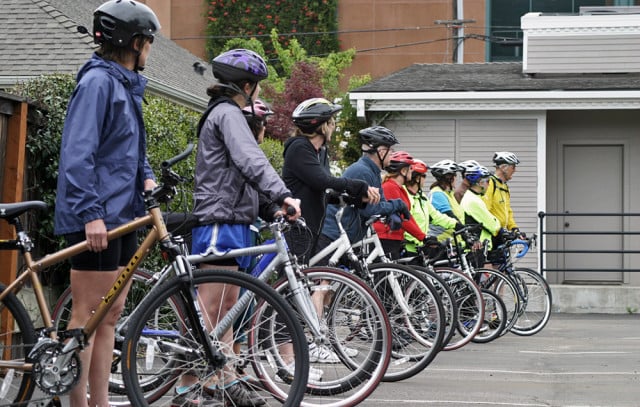How to Learn to Ride a Bike as an Adult
Don't believe the naysayers; it really is never too late to learn how to ride a bike. Here's why!
Don’t believe the naysayers; it really is never too late to learn how to ride a bike. Here’s why!

There’s a common misconception that if you didn’t learn to ride a bike as a kid, you’ve “missed your window” and it’s too late as an adult. But Marilyn Northcotte has been teaching adults in New Zealand to ride and the vast majority of her students (up to age 69!) have mastered the sport. After all, learning to ride as an adult is no harder than learning as a kid, as long as you take the same step-by-step approach to the process—and push grown-up fear and nerves out of the way.
All you need is a bike and a safe, wide-open place to practice, like an empty parking lot or park. The good news is there are no awkward training wheels involved. Here’s how to get started:
Set up your bike
Make sure you’re using a bike you can stand over without the top tube pressing into you. If you can’t do that, you’ll need to pick a smaller-sized bike. Now lower the seat on the bike so that you can sit on the saddle with your feet just resting on the ground. Take the pedals off the bike. You should be able to reach the handlebars and brakes comfortably.
Practice getting on and off
Lean the bike toward you to get on the bike while applying the brakes so it doesn’t roll or wobble. Apply the brakes again when getting off the bike.
Get used to braking
Braking is a pretty crucial skill that Northcotte says will give you a lot of confidence starting out. Walk next to your bike and push it down the street while practicing pulling on the brakes to stop. Make sure you apply pressure evenly on both brakes.
Learn to glide
Now you’re ready to start moving. Northcotte says she teaches the same basic method to adults as children.
“We use the balance method,” she says. “Adults learn to scoot along on their bike using their feet to push off to gain their balance before we teach them to pedal. Scooting along helps them to learn the feeling of balancing on two wheels. The aim is to push off and get both their feet off the ground for as long as they can. If they need to put one foot down to correct their balance, then they put both down and start again. Once they can glide along without touching their feet down to correct themselves, they are ready to begin pedaling.”
Practice your glide until you can keep your feet up for three seconds.
Hone your balance and vision
“Anything that involves balance is helpful and can be used as a point of reference,” Northcotte says. “For example if you’ve ridden a scooter before with both feet on the platform, you should be able to balance on two wheels.”
Look ahead of you at where you want to go, instead of focusing on obstacles to avoid. Keep your eyes up and always look ahead instead of down—it will help you maintain balance and follow your line of vision.
Get ready to pedal
Once you can maintain balance while gliding and have mastered braking and keeping your vision steady, you’re ready to pedal. Add the pedals to your bike if you removed them. Start with one foot on the ground and the opposite foot on a pedal in the two o’clock position to give you some momentum when you push off. Then push down on the pedal and add your other foot as you move forward. You’ll notice the faster you pedal forward the easier it is to maintain your balance. Practice pedaling circles around the park or parking lot. Once you develop confidence, get off the bike and move your seat up so that your feet reach the pedals with only a very slight bend. Practice navigating cones or obstacles until you get the hang of it. You’re riding a bike!

